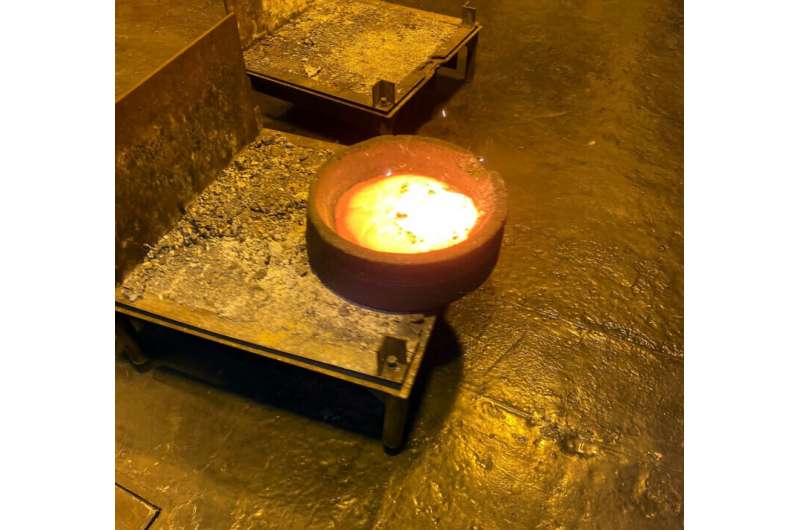This article has been reviewed according to Science X's editorial process and policies. Editors have highlighted the following attributes while ensuring the content's credibility:
fact-checked
trusted source
proofread
Green production of silicon may be just around the corner

Norway is Europe's largest producer of aluminum and silicon. The metal industry is one of the country's most important export industries, but also accounts for 10% of its CO2 emissions.
Norway urgently needs to cut its emission levels in the current production methods in order to reach its climate targets.
Out with carbon
NTNU has taken out a patent for an industrial process that will remove all direct emissions of CO2 and NOx. The process has been named SisAl.
Quartz is the raw material in both the traditional smelting process and using the SisAl method. With today's technology, CO2 is formed when quartz reacts with carbon. Instead of carbon, the SisAl process uses aluminum as a reducing agent, thus avoiding the formation of CO2.
"Technologically, we believe that nothing stands in the way of producing silicon on an industrial scale with the new method. And it's energy-saving," says Maria Wallin, a materials researcher at NTNU.
The SisAl process is exothermic, meaning the reaction between quartz and aluminum releases energy. Today's method is endothermic, and energy needs to be added to reduce the quartz. SisAl uses only one third the energy consumption per ton of finished silicon.
The traditional technology uses 85% to 92% of the quartz that is put in the furnace. SisAl utilizes 97% to 99% because the process can also use quartz in powder form.
Wallin and Professor Gabriella Tranell co-coordinate the large EU projects SisAl Pilot and SisAl Slag, which are led by NTNU. Twenty-two partners in research and industry in Europe and South Africa have developed the process based on NTNU's patent.
Dozens of pilot tests have been carried out at Elkem's pilot center at Fiskaa in Kristiansand and at the Fundiciones Rey foundry in Spain.
Egg of Columbus
Wallin says the SisAl method has a number of other advantages.
In addition to removing all direct emissions of CO2 and NOx and saving energy, the new silicon-making process will use slag (dross) and scrap from the aluminum industry.
The SisAl process can use slag as a reducing agent in silicon production. The same applies to thin aluminum scrap, for example from food packaging.
The SisAl process also creates slag, such as calcium oxide and aluminum oxide, but these are substances that are in demand by the steel industry, says Wallin.
The new smelting process also makes better use of the raw material, because fine quartz ("fines") can be used. In the traditional process, fines have to be removed.
Circular economy
"The challenge we're spending the most time on right now is creating a circular business model that includes the metal industries. We see great opportunities for synergies that would benefit both the environment and the economy," Wallin said.
"We're looking to better utilize raw materials, and to find the lowest possible emissions, less energy consumption, maximum reuse and the least possible waste. The size of tax the authorities place on CO2 emissions is of course also a factor in the calculation," says Wallin.
Next steps
Silicon is produced by Elkem and Wacker in Norway. Wallin believes that today's smelters for silicon could use the SisAl technology without large investments as a supplement, or partial replacement, for current production.
A pilot plant for SisAl production is being built in South Africa as part of an EU project. Wallin considers this a milestone before the eventual construction of a facility on an industrial scale.
EU aiming to be self-sufficient
The EU has designated silicon as a critically important metal. Silicon has semiconductor properties and is a critical material in circuit boards, solar cells and all electronics.
Silicon, in alloys with aluminum, is also a part of many of the everyday materials we use. Today, China accounts for two-thirds of silicon production in the world.
World production of aluminum is 60 million metric tons. Silicon production is 12 million metric tons. Europe produces less than half of its needs. The EU is keen to become more self-sufficient in key metals, which has become a major priority since the invasion of Ukraine. The European Commission also believes that the silicon, aluminum and ferroalloy industries risk being moved to low-cost countries given the stricter environmental requirements in Europe.
Aluminum scrap is exported annually from Europe to the tune of 600,000 metric tons. The EU aims to phase out these exports to avoid losing valuable raw materials.
Norway in a dream position
Thanks to hydropower, Norwegian metal production is among the cleanest in the world. Iceland is in the same class because of its geothermal energy and hydropower.
"Norway is in a unique position to be able to produce silicon and aluminum by even more environmentally friendly methods than is done today. For silicon, I think we're close to a technological shift. A lot is also happening in the aluminum industry. At the same time, the potential for cleaner production and better resource utilization is even greater when two important industries can work together," Wallin said.
"Norway also has the advantage of short transport distances between the facilities of the two industries. We believe the SisAl process can completely replace the current method, but it will probably take time," she said.
A version of the research has been published on the pre-print server SSRN Electronic Journal.
More information: Harald Philipson et al, Preliminary Techno-Economic Considerations of the Sisal Process—Closing Materials Loops through Industrial Symbiosis, SSRN Electronic Journal (2022). DOI: 10.2139/ssrn.4116381


















